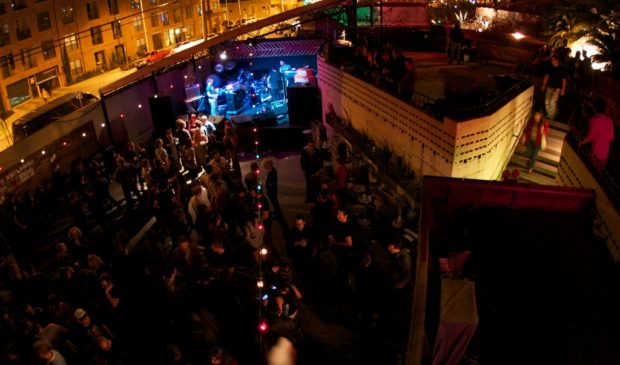All ears on Red River as noise curfew pilot program kicks off
Thursday, May 4, 2017 by
Chad Swiatecki Today marks the official start of a six-month program that will bring later hours for live music to one of the city’s most well-regarded cultural centers.
Known in city channels as the Red River pilot program, the change in city policy will provide three extra hours total on weekends for outdoor music venues to feature music late at night without violating the noise curfews for the district, which stretches from 6th to 12th streets and includes portions of East 7th Street. Under the new rules noise curfews now go into effect at midnight on Thursday evenings and 1 a.m. on Friday and Saturday nights, with sound levels required to stay within the city’s general 85 decibel limit.
Venue operators in the area, which a recent study found is on the verge of being developed out of existence, began pushing for the extended sound curfew late last year as a way to keep crowds around longer and generate more money from alcohol sales. When asked about the potential effect of the later hours on the busiest drinking nights of the week, operators generally expect a revenue increase of between 10 and 20 percent.
“When we have to shut a show down early, either some people don’t show up because it would be over too soon, or you’d have a great show with a bunch of people who would then go off somewhere else,” said Stephen Sternschein, managing partner of Empire Control Room. “We generally start around 8, so if we’re getting 20 percent more time to have people stay three nights a week, then hopefully that’ll increase business by around 10 percent overall.”
Venues around the district seem to be easing into the change, partially since outdoor concerts on big stages get booked months in advance and the pilot program was only approved recently.
City officials will have a presence in the district this weekend to gauge its effects, and will use live online sound-monitoring capabilities to make sure participating clubs are complying with sound limits.
Brian Block, the city’s newly hired entertainment services manager, said he and two other employees will be collecting data throughout the weekend and over the next six months, with a permanent extension possible if the new policy is found to not be an unreasonable disturbance to nearby residents.
“We’ve been in good regular communication with everyone in the district to make sure we’re on the same page, and they will be providing us with the economic data to determine if this change will work,” Block said in reference to learning of clubs’ respective business increases during the program. “We’re also talking about doing a walking tour with some music commissioners so they can get out there and hear how this works out with their own ears.”
While programming longer concerts with more bands is one possible move for venues under the new rules, crowds at Stubb’s BBQ could also receive a break from the heat.
Ryan Garrett, general manager for the 2,100-capacity amphitheater and small indoor club, said the venue typically trims back its outdoor programming in the summer because 7 p.m. temperatures typically are still around 100 degrees. With a later sound curfew, he said 9 p.m. start times become a possibility, with a doubling to more than 20 shows and community events possible.
“Currently we only have a few shows in the course of each of those months, but this gives us a different time frame that brings a big economic opportunity,” he said.
Garrett added that the new policy became possible after the venues in the area known as the Red River Cultural District formed a merchants association and began collaborating on ways to solve their common problems.
“This is absolutely a product of the neighborhood getting more organized and finding the objectives we wanted to organize the district,” he said. “Before creating this merchant association I never knew Cody (Cowan) at Mohawk or Stephen at Empire, and it’s cool what you can do when you come together.”
Photo by Nash Cook made available through a Creative Commons license.
The Austin Monitor’s work is made possible by donations from the community. Though our reporting covers donors from time to time, we are careful to keep business and editorial efforts separate while maintaining transparency. A complete list of donors is available here, and our code of ethics is explained here.
You're a community leader
And we’re honored you look to us for serious, in-depth news. You know a strong community needs local and dedicated watchdog reporting. We’re here for you and that won’t change. Now will you take the powerful next step and support our nonprofit news organization?









